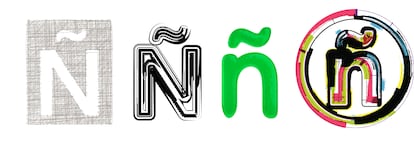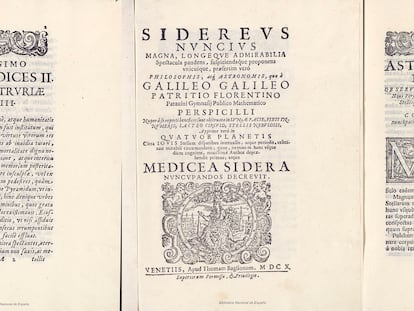The letter ‘Ñ,’ the identity of Spanish the world over
The character has its origins in the Middle Ages, and is the only one to have been created in Spain. Despite this, it was omitted from the Spanish Royal Academy dictionary until 1803

There’s no español without ñ. Not to mention cañas. Ñ is the 15th letter in the Spanish alphabet and is used in more than 15,700 words. To mark April 23, the Day of the Book, which since 2003 has also been the Day of the Spanish Language, EL PAÍS retraces the history of this special letter and examines how it has become an icon of the Spanish language.
The letter ñ was first included in the dictionary of the Royal Spanish Academy (RAE) in 1803. But its origins stretch to the Middle Ages. Indeed, the letter appears in a text dating back to 1176.
Neither the sound or the letter ñ existed in Latin, but as the Latin language evolved and romantic languages such as Spanish, French and Italian began to appear, so too did the palatal nasal sound, which is articulated with the back of the tongue raised to the hard palate.
In the Middle Ages, monks were the scholars of society and monasteries great centers of knowledge. The letter ñ is thought to have originated at this historic moment due to the shortage of scrolls, which were very costly, and in a bid to save time. It seemed the monks, who worked as scribes and clerks in the monasteries, were forced to abbreviate some double letters to fit more words in each line.
It was not until October 2, 2007, that the ñ, as well as other tildes, could appear in email addresses and web domains
According to this theory, the second repeated letter was represented as a tilde, known in Spanish as a virgulilla, over the first. In other words, what we know as the ñ is in fact a double n, so instead of donna, we have doña.
There is a separate theory about how the sound of the letter came about. According to this theory, the letter ñ emerged as a way to represent the new palatal nasal sounds that appeared in the ninth century – for example, the double n in Latin words such as annus (año, or year). These words meant more work for the monks and so in their effort to save time, different adaptations began to emerge depending on the language. The letter ñ was used in Spanish and Gallego (España); the nh combination in Portuguese (Espanha); gn in French and Italian (Espagna); and ny in Catalan (Espanya).
These different forms continued to be used interchangeably until the 13th century, when King Alfonso X of Castile and León ordered a spelling reform as part of his policy of linguistic unification. The monarch, loyal to his reputation as a great reader, writer and intellectual of the times, introduced the letter ñ as the preferred option to the above combinations and in doing so set the first rules of the Spanish language. When the use of ñ became widespread across the Iberian peninsula, humanist Antonio de Nebrija included the letter in the first Spanish grammar book in 1492.
But it was not too long ago that the letter ñ was at risk of disappearing, at least from the written language. In the 1990s, the European Economic Community (EEC) proposed eliminating the ñ to make keyboards more uniform. The internet had also sidelined the letter. It was not until October 2, 2007, that the ñ, as well as other tildes, could appear in email addresses and web domains.
The letter is even starting to make more appearances in the English language in words with Spanish origin such as jalapeño, piña colada and El Niño
The proposal from the EEC sparked a fierce backlash in defense of ñ and Spanish, which is the second-most-spoken language in the world. Even Nobel Prize laureate Gabriel García Márquez rushed to defend the letter. “It is scandalous, to say the least, that the European Economic Community has dared to propose that Spain eliminate the letter ñ of our alphabet, and even worse, only for reasons of commercial convenience,” he wrote in an op-ed for EL PAÍS in 1991. “The authors of such abuse and arrogance should know that the ñ is not an archaeological relic, but the reverse: a cultural leap by one Romance language that left the others behind, expressing with only one letter a sound that in other Romance languages continues to be expressed with two.”
The controversy ended on April 23, 1993, when the Spanish government approved a royal decree that maintained the mandatory inclusion of the letter ñ on keyboards.
The letter is even starting to make more appearances in the English language in words with Spanish origin such as jalapeño, piña colada and El Niño. Until the middle of the 20th century, the ñ was more commonly written in English as the double n, as in the Battle of Corunna. But now the letter is almost always respected and there is even an association, the Society for the Advancement of Spanish Letters in the Anglo Americas, that is pushing for the ñ to be permanently adopted in the English language.
But it is important to note that neither the letter ñ nor the sound are exclusively Spanish. In the Iberian peninsula, it is used in Gallego and Asturian, and also to a limited degree in the Basque language Euskera. In Latin America, many indigenous languages also include the letter, such as Mapuche in Chile and Argentina, Zapotec in Mexico and Quechua in Ecuador. And it also appears in other languages of cultures that came into contact with Spanish, including Chabacano in the Philippines and Bube in Equatorial Guinea.
English version by Melissa Kitson.
Tu suscripción se está usando en otro dispositivo
¿Quieres añadir otro usuario a tu suscripción?
Si continúas leyendo en este dispositivo, no se podrá leer en el otro.
FlechaTu suscripción se está usando en otro dispositivo y solo puedes acceder a EL PAÍS desde un dispositivo a la vez.
Si quieres compartir tu cuenta, cambia tu suscripción a la modalidad Premium, así podrás añadir otro usuario. Cada uno accederá con su propia cuenta de email, lo que os permitirá personalizar vuestra experiencia en EL PAÍS.
¿Tienes una suscripción de empresa? Accede aquí para contratar más cuentas.
En el caso de no saber quién está usando tu cuenta, te recomendamos cambiar tu contraseña aquí.
Si decides continuar compartiendo tu cuenta, este mensaje se mostrará en tu dispositivo y en el de la otra persona que está usando tu cuenta de forma indefinida, afectando a tu experiencia de lectura. Puedes consultar aquí los términos y condiciones de la suscripción digital.
More information
Archived In
Últimas noticias
Maduro pleads not guilty before the federal court in New York: ‘I am still the president of Venezuela’
A new test can detect Alzheimer’s from a finger prick
UN team enters Sudanese city of El Fasher after paramilitary massacre: ‘It’s like a ghost town’
A recipe for resistance: Indigenous peoples politicize their struggles from the kitchen
Most viewed
- Gilles Lipovetsky: ‘If you want to live better and fall in love, take Prozac, don’t look to philosophy’
- Alain Aspect, Nobel laureate in physics: ‘Einstein was so smart that he would have had to recognize quantum entanglement’
- Alvin Hellerstein, a 92-year-old judge appointed by Bill Clinton, to preside over Maduro’s trial in New York
- Why oil has been at the center of Venezuela-US conflicts for decades
- Maduro’s downfall puts China’s relationship with Venezuela to the test










































